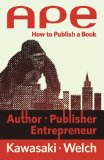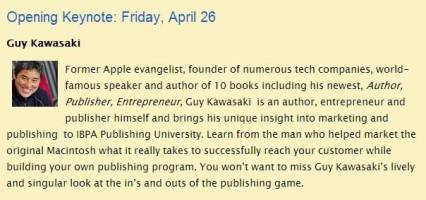[amazon_link id=”0988523108″ target=”_blank” container=”” container_class=”” ] [/amazon_link]As many readers know, I wear several hats. One of them is the founder of The Reading Tub, a family literacy nonprofit I created in 2003. Our primary mission is to connect families with books that are engaging and meet their interests. My usual reading is books written for a youth audience.
[/amazon_link]As many readers know, I wear several hats. One of them is the founder of The Reading Tub, a family literacy nonprofit I created in 2003. Our primary mission is to connect families with books that are engaging and meet their interests. My usual reading is books written for a youth audience.
In fact, I my mantra is I only read books for kids. BUT … when I saw [amazon_link id=”0988523108″ target=”_blank” container=”” container_class=”” ]APE: Author Publisher Entrepreneur – How to Publish a Book[/amazon_link], co-authored by Guy Kawasaki and Shawn Welch, I thought it might give me greater insight into the self-publishing world so I can more effectively communicate with authors who want reviews. I also thought it would help me in my work with the Mom’s Choice Awards, too.
I could not have predicted just how valuable this book would be. First, I L-O-V-E the term “artisanal publishing.” It speaks so much more effectively to craft, independence, and closer connections to an audience.
APE is available as an e-book (I got my copy via Net Galley) or printed traditionally. The great thing with reading the digital version is that I can see all of my margin notes and my highlighting all in one place. In prepping for this review, several themes emerged from that collection:
- APE is for any entrepreneur, not just authors and publishers.
- APE lays out the critical questions to help you.
- APE guides you through your options so you can pick the best marketplace for your product.
For the rest of my review, we’ll take each of these themes in turn. Whether you are new to business, a budding or experienced artisanal publisher, or just want to better understand Marketing 2.0 Guy Kawasaki and Shawn Welch have made it unbelievably easy to get started or get to the next level.
By the time you get to Chapter 3, you will recognize the countless hours of research and “fails” (as my 11-YO likes to say) they have saved you.
APE is for any entrepreneur, not just authors or publishers.
In Chapter 1 [“Should You Write a Book?”] Guy lists all of the reasons an author may want to write and publish a book.
Any of these reasons may be true for the author, but they are not relevant for readers.
Bottom line: If you have a consumer you are trying to reach, you need to look at the world through their lenses. To be successful in marketing and selling your product, you have to understand why they want to buy it.
It seems simple enough, but as Guy and Shawn point out – even though we hope authors make lots from royalties, it isn’t the reason we (as readers) buy their books. Don’t forget your consumer’s motivation.
APE lays out the critical questions to help you
What is your motivation? In talking about the reasons for writing a book, Guy suggests that popular demand is a bad one. Have “lots of people” told you that you should write a book, start your own business, open your own restaurant …?
Exactly how many is “lots”? Divide that number by a hundred to estimate how many people will buy your book. Then divide that number by four to estimate how many people will actually read your book. [emphasis in original]
Food for thought, no? Here are two more questions they pose. Not in these words, but in the way they lay out information for you to think about.
How will you handle marketing? In my many years of working with authors, most of them ultimately tell me that they never realized that writing their book was the easy part. Marketing was something
(a) they thought the publisher would do; or
(b) they thought the book would market itself.
As APE explains, neither is reality. Where Guy Kawasaki adds insight to the discussion is in sharing a quote from Jean-Louise Gassee, his old boss at Apple.
Do you know what the difference is between PR and advertising? Advertising is when you say how great you are? PR is when people say how great you are. PR is better.
So who can you get to help you with PR? APE can help.
Although APE does not focus on identifying and understanding your target audience, engaging your audience for PR is covered thoroughly: why you need them; their value, and the challenges self-published authors face in getting them. Chapter 28 focuses on “how to pitch your book to bloggers, reviewers, and thought leaders.”
Bottom line: Professionalism rules the day. To quote Guy: “Show some class.”
- Avoid “shotgun” pitches to hundreds of reviewers with a form letter. Do the research, establish expertise, personalize, disclose your interests, to name a few of the recommendations.
- Make your product your best. APE identifies some of the “giveaways” or “clues” that can make a book stand out as “self published” in the stereotypical sense.
APE helps you position yourself for the marketplace
When he gets to the Entrepreneur section of APE, Guy Kawasaki offers example after example of why the “creator” needs to take the long view (“pay your dues”). He explains why building your platform (marketing and brand infrastructure) can’t wait until your book is done.
Where APE excels the most, in my opinion, is this section of the book. The authors guide you realistically and candidly through all aspects of decision making.
- Learn (and link to) social media services AND how to create a social media profile.
- Get advice – and links to – about the best practices for using social media to reach your goals.
- Read about how Guy and Shawn created APE in gritty detail (hardware, software, publisher, etc).
[amazon_link id=”0988523108″ target=”_blank” container=”” container_class=”” ] [/amazon_link]Reading [amazon_link id=”0988523108″ target=”_blank” container=”” container_class=”” ]APE: Author, Publisher Entrepreneur – How to Publish a Book[/amazon_link] is like having an expert hold your hand.
[/amazon_link]Reading [amazon_link id=”0988523108″ target=”_blank” container=”” container_class=”” ]APE: Author, Publisher Entrepreneur – How to Publish a Book[/amazon_link] is like having an expert hold your hand.
The information is plentiful, but not overwhelming, and it is clear that the authors’ goals are to share knowledge. There is no aspect of transforming an idea to a marketed product that will leave you with any extra questions.
About Guy Kawasaki and Shawn Welch
 Guy Kawasaki is the Opening Keynote Speaker at IBPA Publishing University in Chicago, IL, April 26-27, 2013. Go figure, I won’t arrive in time to hear his talk! But I will be in New York when he is the Keynote speaker at uPublishU on Saturday, June 1, 2013 during Book Expo America.
Guy Kawasaki is the Opening Keynote Speaker at IBPA Publishing University in Chicago, IL, April 26-27, 2013. Go figure, I won’t arrive in time to hear his talk! But I will be in New York when he is the Keynote speaker at uPublishU on Saturday, June 1, 2013 during Book Expo America.

Guy Kawasaki is the author of APE, What the Plus!, Enchantment, and nine other books. He is also the co-founder of Alltop.com, an “online magazine rack” of popular topics on the web. Previously, he was the chief evangelist of Apple. Kawasaki has a BA from Stanford University and an MBA from UCLA as well as an honorary doctorate from Babson College. [read more at www.guykawasaki.com]
 Shawn Welch is the author of From Idea to App, iOS 5 Core Frameworks, and iOS 6 for Developers as well as the developer of several iOS apps. Previously he worked as a senior media-editor for Pearson Education. He also helped pioneer many of Pearson’s earliest efforts in iPad solutions. Welch has a BS from Kansas State University. Learn more about Shawn at www.anythingsimple.com
Shawn Welch is the author of From Idea to App, iOS 5 Core Frameworks, and iOS 6 for Developers as well as the developer of several iOS apps. Previously he worked as a senior media-editor for Pearson Education. He also helped pioneer many of Pearson’s earliest efforts in iPad solutions. Welch has a BS from Kansas State University. Learn more about Shawn at www.anythingsimple.com
.
